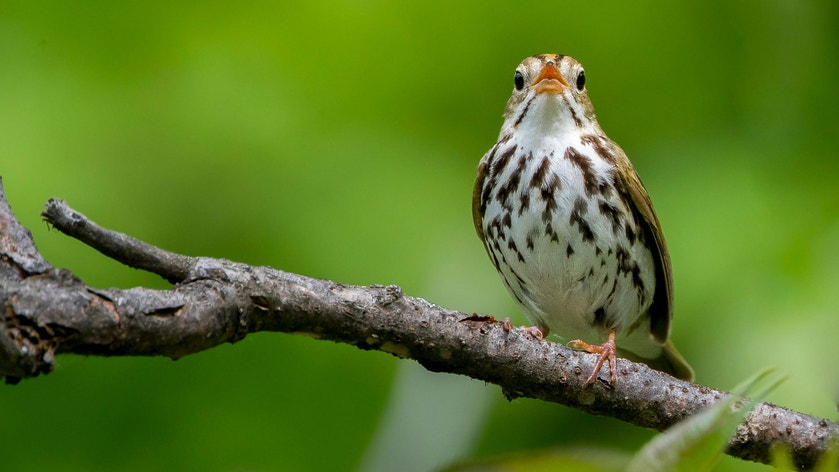Ovenbird
At a Glance
In shady woods, this odd warbler walks with deliberate steps on the forest floor, holding its short tail cocked up higher than its back. Although it is not especially shy, its choice of habitat often makes it hard to observe; its ringing chant of teacher, teacher is heard far more often than the bird is seen. The name 'Ovenbird' is a reference to the bird's nest, a domed structure with the entrance on the side, like an old-fashioned oven.
All bird guide text and rangemaps adapted from Lives of North American Birds by Kenn Kaufman© 1996, used by permission of Houghton Mifflin Harcourt Publishing Company. All rights reserved.
Category
Perching Birds, Wood Warblers
IUCN Status
Least Concern
Habitat
Forests and Woodlands, Shrublands, Savannas, and Thickets
Region
Alaska and The North, California, Eastern Canada, Florida, Great Lakes, Mid Atlantic, New England, Northwest, Plains, Rocky Mountains, Southeast, Southwest, Texas, Western Canada
Behavior
Direct Flight, Flitter
Population
26.000.000
Range & Identification
Migration & Range Maps
Migrates mostly at night. Ovenbirds nesting east of the Appalachians may go to the Caribbean for the winter, while those from west of the Appalachians are likely to migrate to Mexico or Central America.
Description
6" (15 cm). Bold white eye-ring, striped chest, olive-brown back. Dull orange crown stripe bordered by blackish stripes. Brown thrushes lack crown stripes. Behavior is a good clue, as it walks deliberately on the ground, with tail held up.
Size
About the size of a Robin, About the size of a Sparrow
Color
Black, Brown, Orange, Red, White
Wing Shape
Rounded
Tail Shape
Notched, Rounded, Square-tipped
Songs and Calls
Loud staccato song-teacher, teacher, teacher-with geographical variation in emphasis. Flight song, often given at night, is bubbling and exuberant series of jumbled notes ending with the familiar teacher, teacher.
Call Pattern
Flat, Undulating
Call Type
Chirp/Chip, Whistle
Habitat
Near ground in leafy woods; in migration, thickets. Needs large tracts of mature deciduous or mixed forest for successful breeding. Will nest in a wide variety of forest types, as long as they have a closed canopy cover, large trees, and little ground cover. In winter (mostly in tropics), lives in forests and thickets, from dry lowlands to wet forests in the foothills.
Sign up for Audubon's newsletter to learn more about birds like the Ovenbird
Behavior
Eggs
Normally 4-5. White with gray and brown spots. Incubation by female only, fed sometimes by male. Cowbirds parasitize many nests, but Ovenbird nestlings often survive even when sharing the nest with young cowbirds.
Young
Both parents feed nestlings. Young leave the nest after 7-10 days, can only hop and flutter at this stage; fed by adults for another 10-20 days. 1 brood per year, but has been known to produce up to 3 broods in response to a spruce budworm outbreak.
Feeding Behavior
Takes insects from leaf litter while walking on ground and rotting logs. (Young Ovenbirds pass through a stage of hopping while they forage.) Sometimes probes among leaf litter, hovers to take insects from foliage, or catches them in mid-air. Individuals probably defend feeding territories in winter.
Diet
Mostly insects. During summer, feeds on a wide variety of insects including adult beetles and their larvae, ants, caterpillars, flies, true bugs, and others; also worms, spiders, snails. Winter diet not well known, but reportedly includes seeds and other vegetable matter.
Nesting
Male sings to attract female to nesting territory, and sings only sporadically during actual courtship. Male threatens rival males by tilting tail upward, drooping wings, and kneading with feet. Nest: Placed on the ground where ground cover is sparse, especially near trails or roads. Female chooses site, builds domed nest from dead leaves, grass, bark, twigs; lines it with animal hair.
Conservation
Conservation Status
Despite heavy parasitism by cowbirds in some areas, overall numbers seem to be holding up well.
Climate Threats Facing the Ovenbird
Choose a temperature scenario below to see which threats will affect this species as warming increases. The same climate change-driven threats that put birds at risk will affect other wildlife and people, too.






